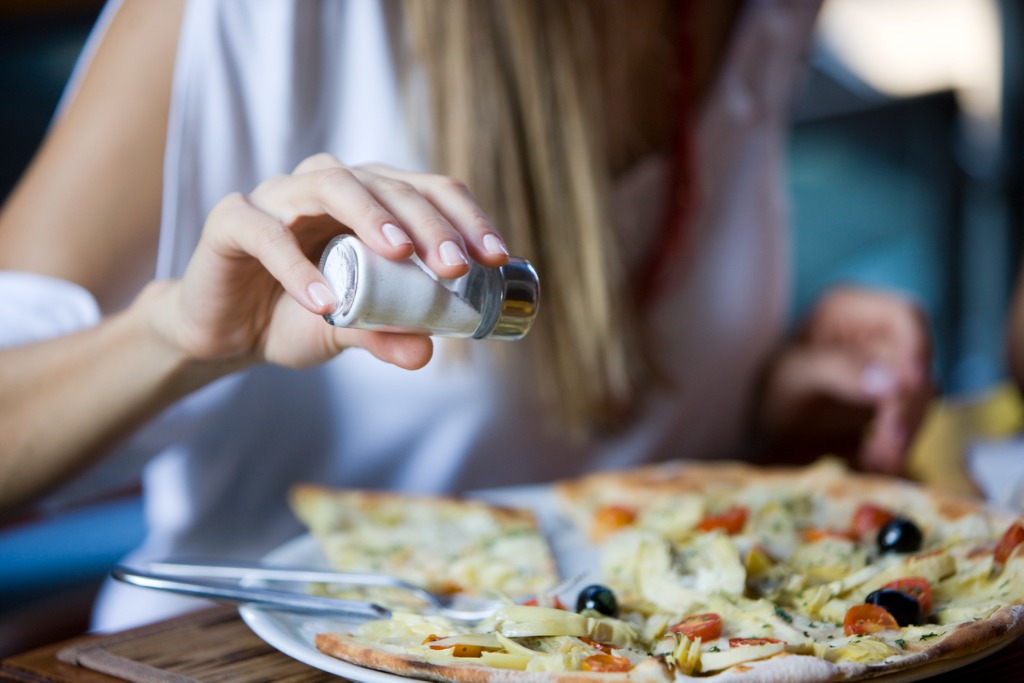Effect of Salt on Blood Pressure

The positive relationship between salt intake and high blood pressure has been well-established. While this relationship was first recognized over a century ago,1 rigorous studies involving large numbers of diverse participants have been conducted over the past several decades.2 One such example was the INTERSALT study, which collected data from over 10,000 participants located in over 50 worldwide centers to show a highly positive relationship between salt intake and increased blood pressure: specifically, the study found that a consistent 6g/day increase in sodium consumption over the course of 30 years was associated with a 9 mmHg increase in systolic blood pressure.3 Studies aiming to quantify the effects of salt reduction have likewise shown this positive relationship.4
While there is consensus that excess dietary salt is the single greatest controllable contributor to increased blood pressure,5 the exact mechanisms by which high levels of salt increase blood pressure are still a topic of research. Taking into account known phenomena associated with high blood pressure, such as increased blood plasma concentrations of sodium ions and increased sympathetic nerve activity, Blaustein et al.6 proposed a unified hypothesis for the mechanism of salt-induced high blood pressure. They argue that dietary salt directly increases sodium ion concentration, which in turn raises plasma levels of endogenous ouabain. Endogenous ouabain is an adrenal cortical hormone that acts as a ligand to the Na+ pump, thereby increasing intracellular Na+ concentration.7 This begins a signaling pathway that ultimately triggers increased activity of the sympathetic nerve, which, among its many functions, constricts blood vessels, directly leading to increased blood pressure.
Current FDA guidelines recommend limiting sodium intake to 2.3 g/day (about one teaspoon of table salt) for healthy individuals under 50, while the recommended limits for the elderly, children, and those at-risk for high blood pressure are even lower.8 A 2017 study, however, questioned whether these recommendations are supported by data. Moore et al.9 collected data from over 2,500 normotensive subjects and measured the effects of sodium and potassium intake on blood pressure. Surprisingly, the researchers found that higher levels of sodium intake were correlated with lower levels of systolic and diastolic blood pressure. While this seems to contradict previous data, the authors also note that many of the individuals in the study also had high levels of potassium intake, which is known to independently decrease blood pressure. Moore et al. concluded there is no evidence to support the FDA’s specific guidelines and that more research is needed to further elucidate the role sodium, potassium, and other minerals play in regulating blood pressure.
The vast amount of research, however, unequivocally supports the notion that elevated sodium intake raises blood pressure and, as a result, presents other adverse health outcomes. High blood pressure directly increases the risk for other cardiovascular diseases, and the data show that salt intake is positively correlated with these diseases.10 A 5g/day higher salt intake is associated with a 23% greater risk of stroke and a 17% greater risk of cardiovascular disease.11 As such, governments and international bodies have sought to curtail salt consumption through advocacy and educational programming. The World Health Organization, for example, hopes to lower salt intake to less that 5g per person per day by 2025.10
References
1. Alderman, M. H. Salt, Blood Pressure, and Human Health. Hypertension 36, 890–893 (2000).
2. He, F. J. & MacGregor, G. A. Salt and sugar: their effects on blood pressure. Pflügers Archiv – European Journal of Physiology 2014 467:3 467, 577–586 (2014).
3. Rose, G. et al. Intersalt: an international study of electrolyte excretion and blood pressure. Results for 24 hour urinary sodium and potassium excretion. Intersalt Cooperative Research Group. British Medical Journal 297, 319–328 (1988).
4. Macgregor, G. A., Sagnella, G. A., Markandu, N. D., Singer, D. R. J. & Cappuccio, F. P. Double-blind study of three sodium intakes and long-term effects of sodium restriction in essential hypertension. The Lancet 334, 1244–1247 (1989).
5. PM, K. et al. Global burden of hypertension: analysis of worldwide data. Lancet (London, England) 365, 217–223 (2005).
6. Blaustein, M. P. et al. How NaCl raises blood pressure: a new paradigm for the pathogenesis of salt-dependent hypertension. https://doi.org/10.1152/ajpheart.00899.2011 302, 1031–1049 (2012).
7. Blaustein, M. P. Endogenous ouabain: Role in the pathogenesis of hypertension. Kidney International 49, 1748–1753 (1996).
8. Sodium in Your Diet | FDA. https://www.fda.gov/food/nutrition-education-resources-materials/sodium-your-diet.
9. Moore, L. L., Singer, M. R. & Bradlee, M. L. Low Sodium Intakes are Not Associated with Lower Blood Pressure Levels among Framingham Offspring Study Adults. The FASEB Journal 31, 446.6-446.6.
10. Cappuccio, F. P. Cardiovascular and other effects of salt consumption. Kidney International Supplements 3, 312 (2013).
11. P, S., L, D., NB, K. & FP, C. Salt intake, stroke, and cardiovascular disease: meta-analysis of prospective studies. BMJ (Clinical research ed.) 339, 1296 (2009).
